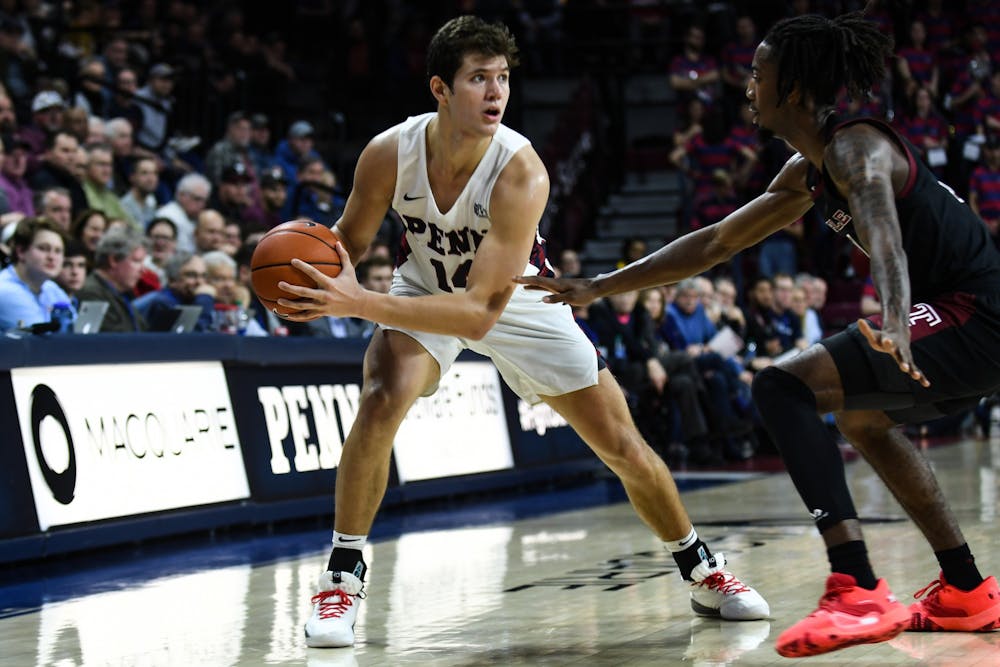For the past two years, we've seen two Penn men's basketball teams.
Some nights, we see a team that struggles to make shots, plays poorly against conference opponents, and — especially this season — doesn't effectively defend three-point shots. Three consecutive losses this season to Princeton and Saint Joseph's — two teams with losing records — tell the whole story.
Other nights, the Quakers knock down shot after shot and can play with the best teams in the country. Penn's wins against power-conference teams Providence, Central Florida, and Alabama are examples of what the Quakers can do at their peak.
Penn's gritty win on Saturday over Temple is a testament to the Quakers' talent and their ability to adapt to different game scenarios. The Quakers can grind out defensively-backed wins against tough conference opponents, but they can also keep up with high-caliber squads like Villanova.
But this also leaves the question: why can't Penn consistently produce at both ends of the floor?
There a few potential explanations for this. One is that coach Steve Donahue's game plan allows Penn to better match up against high-quality opponents. High-major teams are generally more athletic than mid-major squads, but Donahue's emphasis on basketball IQ allows the Quakers to compete with teams like Villanova and Alabama.

Another is that the Red and Blue are bound to go cold from beyond the arc with the volume of threes they are shooting. Penn attempts 27.3 three-pointers per game, so while they may be hot from downtown one night, the Quakers are bound to go cold other nights.
RELATED:
https://www.thedp.com/article/2020/01/penn-mens-basketball-landau-princeton-column-three-pointers
https://www.thedp.com/article/2019/12/penn-mens-basketball-papazekos-column-villanova-steve-donahue
There is merit to both of these arguments, but they don't tell the whole story.
Steve Donahue's offensive strategy consists of shots in the paint and three-pointers. Players on the team are encouraged to not take midrange shots, which are inefficient according to advanced analytics.
With this strategy, though, the Quakers need the personnel to execute; they need more three-point marksmen. Injuries to sophomore forward Michael Wang, sophomore guard Bryce Washington, and senior forward Kuba Mijakowski have clearly factored into the Quakers' struggles from behind the arc. Freshman forward Max Martz, who has shot 51.2% from three this season, has helped the Quakers significantly, but senior guard Ryan Betley is the only other player who shoots over 35% from long-range (minimum of 10 shot attempts).
Even last year, when the Quakers went 7-7 in conference play, Penn had five players who shot 34% or better from three. The year before that, they had six players that shot 36% or better from three.
This year, Penn needs to focus on getting healthy. Washington and Mijakowski could still return this season, as could freshman guard Jonah Charles, who hasn't seen the court yet this year. Guards Devon Goodman, Jordan Dingle, and Betley need to continue their solid play as well.
Going forward, though, the Quakers could benefit from focusing their recruiting efforts on three-and-D guys who can space the floor. Martz has proven his ability to be a complementary shooter who can score in bunches, and the Quakers need this more than ever as they look to return to the NCAA Tournament.
JACKSON JOFFE is a College and Wharton sophomore from Nashville, Tenn. and a Senior Sports Associate for The Daily Pennsylvanian. He can be reached at joffe@thedailypennsylvanian.com.









